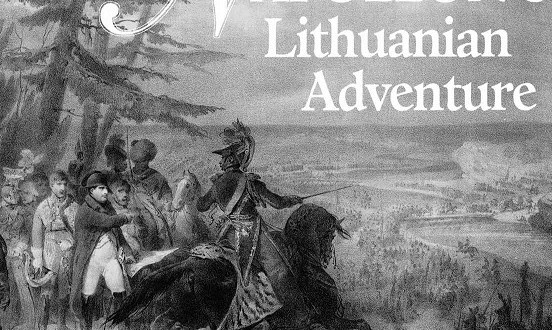by Vytas Kernius.
While the arrival of the French Emperor in Lithuania was all fun and games, his departure turned out to be a disaster.
IN THREE SUCCESSIVE PARTITIONS during the second part of the 18th century – and particularly the last one in 1795 – Austria, Prussia and Russia destroyed the Lithuanian-Polish Commonwealth, but not the spirit nor the hopes of its people.
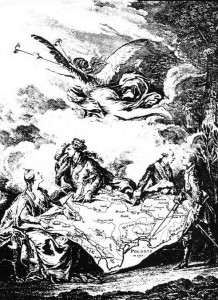
Following the unsuccessful revolt led by Tadas Kosciuš ka in 1794 against the Russians, many of the participants were incarcerated, put to death, or exiled to Siberia. Others fled to the West. A number of these, including members of some of the most prestigious families of Lithuania, ended up in France, England and other countries. Here they hoped to persuade the governments of these countries to offer them support in the fight to regain the independence of their country.
Catherine the Great of Russia, chief architect of the partitions, died in 1796, and her son Paul assumed the throne as Czar. In the summer of the same year, the Lithuanian magnate Mykolas Kleopas Oginskis addressed a letter to Napoleon Bonaparte, an energetic French general leading the Italian campaign, asking for his help. Napoleon replied: “How can I help you? A country oppressed by its neighbors can only free itself by taking arms against its oppressors”.
The negotiations continued, and by 1797 Napoleon approved and encouraged the formation of the so-called Polish Legion under General Dabrowski, which consisted of citizens who had emigrated from the occupied Commonwealth, both Lithuanians and Poles. Tadas Kosciuška, who had returned to France from America in 1798, rejected Napoleon’s offer of high command and remained distrustful of the latter’s intentions.
Nevertheless, the patriots hoped that during Napoleon’s inevitable war with the Austrians, the Polish Legion would eventually cross into occupied Poland and both the Poles and Lithuanians would rise against the Russians. Of course, at that time they had no way of knowing they would have to wait a few years before their dreams would become reality. In the meantime Napoleon took advantage of these troops to further his own goals. He used them in Italy, Egypt and even to suppress the revolt of slaves in Santo Domingo. Here many of the soldiers became discouraged, deserted their units, and returned home.
In 1801 Alexander I became Czar of all Russias, and in 1804 Napoleon assumed the title of Emperor of the French. The following year he defeated the Austrian-Russian coalition at Austerlitz. In 1806 Napoleon began the invasion of Prussia. Before completing his conquest, he carefully encouraged the hopes of the Lithuanians and Poles for the reestablishment of their state. He invited Kosciuška to lead a revolt against the Prussians, and urged him to form an army. Kosciuška refused.
The campaign against Prussia ended when Napoleon defeated the allied Prussian-Russian forces in the battle of Friedland in June of 1807. The Emperor and the Czar agreed to meet near the city of Tilže (Tilsit), on the border between Prussian Lithuania and Russian-occupied Lithuania. Here, in a pavilion built on a pontoon in the middle of the Nemunas river, they signed a peace treaty. The defeated king of Prussia, Frederick William, was also invited. By this treaty, both Napoleon and Alexander pledged mutual assistance, and Prussia was compelled to renounce all territories west of the Elbe river, as well as the ones it seized as result of the last partition of the Lithuanian-Polish Commonwealth. From the latter ones a new country called the Duchy of Warsaw was created, with Frederick Augustus of Saxony as its ruler.
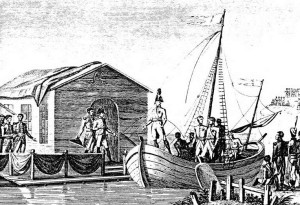
of the Nemunas river near Tilžė.
The faith that the Lithuanians had placed in Napoleon received a severe blow at Tilže, when the Emperor and the Czar had come to rather friendly terms and thereby implicitly consigned Lithuania to the continuance of Russian domination.
The previous enlistment of Lithuanians in the French forces, as well as the mission of the secret embassy of Lithuanian nobles to Napoleon at Tilže, only served to incur the wrath of the Russian Czar.
The years following the meeting at Tilže witnessed the gradual decline in the ardor of French and Russian relations. In face of various circumstances, which steadily strained the friendly ties between France and Russia, and seemed to hasten an armed conflict between the two powers, Lithuanian nobles sought to wrest from the czar various concessions in behalf of themselves and Lithuania in return for a promise of loyalty in the event of a French invasion. Various projects for the reestablishment of the Grand Duchy of Lithuania w ere therefore proposed and concocted, although not one was ultimately realized.
The threatening war between Napoleon and Russia became a gruesome reality in the spring of 1812. And Lithuania was then laid open for the devastation of invading and retreating armies.
On June 24 of that year, while the Czar was visiting Vilnius, news reached him that Napoleon had crossed the Nemunas river near Kaunas into Russian-occupied Lithuania at the head of a huge army. All Russian forces retreated. The Czar fled to the interior of Russia.
In Kaunas, Napoleon received in audience the city’s mayor and other Lithuanian noblemen, and concerned himself with the preparation of his army.
Five days later, the French arrived in Vilnius. A hurriedly formed committee of Lithuanian nobles greeted Napoleon on the outskirts of the city. The Emperor entered Vilnius through the Gate of Dawn (Aušros vartai). Here, as in Kaunas, he did not receive the expected enthusiasm from the people that he had received in Poland. Noticing it, Napoleon remarked: “These Poles are different from the ones in Warsaw!”
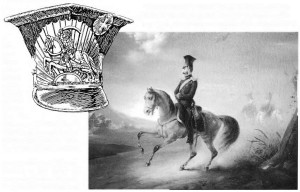
In Vilnius, Napoleon allowed the formation of a Provisional Lithuanian Government, which was entrusted with the task of supplying the French with provisions and the organization of a Lithuanian army, but not governing the country. Many nobles who had served as officers in the Czar’s army, such as Radvilas, Giedraitis, Tiškevicius and others, ruptured their ties with Alexander and joined Napoleon. Four Lithuanian infantry and five cavalry regiments were hastily conscripted. Hundreds of students from the Vilnius University flocked to the ranks of the newly formed units. Of particular mention is the 17th Regiment of Lithuanian Lancers, formed and led by Count Tiškevicius. This unit not only participated in the entire Russian campaign, but also distinguished itself in numerous other campaigns fought by Napoleon throughout Europe during the following three years.
Upon arrival in Lithuania Napoleon began the reorganization of the country’s political structures and implemented a number of reform s. The cities and provinces would be governed by Lithuanian officials under supervision by the French. Serfdom was abolished, an action which did not please many of the gentry and caused confusion among the peasantry. As a result, it was reinstated shortly afteiwards.
Vilnius became Napoleon’s temporary capital (he always referred to it as the capital of Lithuania). Here were assembled the diplomatic corps, France’s foreign affairs minister, and many other important civil and military officials.
Napoleon took a few sight-seeing trips of the city. He visited with workers who were rebuilding the bridge over the Neris river – destroyed by the retreating Russians – and provided them beer, which he also drank with the workers. He rode to the top of the Hill of Gediminas, from which through a field glass explored the city and environs. He was extremely impressed with the beautiful architecture of the ancient city. A story relates that after seeing the Gothic St. Anne’s Church, Napoleon commented that he wished he could place it on the palm of his hand and take it back with him to Paris.
Napoleon remained in the Lithuanian capital about a month, during which time normal life returned to the city. Balls and receptions became a daily activity among the nobles. The Emperor received in audience the city’s mayor, the bishop, the rector of the university and other officials.
Once again Lithuanians hoped to rely upon French intervention as a means of gaining the liberation of their country. However, like Czar Alexander earlier, the French Emperor refused to commit himself to any definitive decision, in spite of the urgent requests from various delegations of Lithuanian nobles. He even refused to consider the unanimous decision reached by the nobles of Poland and Lithuania at the extraordinary Diet (Congress) of Warsaw that the Lithuanian-Polish Republic be promptly restored with all its historical territories. Apparently, the Emperor was not anxious to compromise himself in the eyes of his other allies, Austria and Prussia. In the middle of July Napoleon left Vilnius, without having clarified his attiaide toward the aspirations of both Lithuanians and Poles.
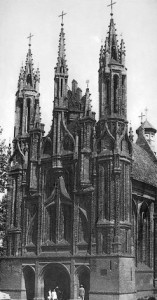
By this time the French army had engulfed the entire territory of Lithuania. The right wing, led by Jerome Bonaparte, had crossed the Nemunas river near Gardinas (Grodno), and was heading east. The left one, led by General McDonald had crossed the river near Tilže and Jurbarkas, and was marching north through Taurage, R aseiniai, Telšiai and Šiauliai toward Latvia.
The Provisional Government was having a hard time trying to keep up with the supplying of the French troops. It lacked money and resources, and was constantly obstructed by French bureaucracy. The peasants were constantly harassed, their farms looted by soldiers and deserters. Many fled into the forests with their livestock, and their fields were left unattended. The government also had a difficult time conscripting men into the army. A few nobles formed their own units at their own expense. The Lithuanian Tartars – descendants of those that Vytautas the Great settled in Lithuania in the 14th century- came to the rescue of their adopted country by forming a cavalry regiment.
In addition to Lithuanian officers who had previously served in the Czar’s army and had volunteered to command units, many others helped Napoleon in one way or another during his entire Russian campaign. Oginskis headed a group of 20 officers who formed Napoleon’s personal guard. Kozakovskis, Moravskis and Sanguška were interpreters and intelligence gatherers, and Pacas was on Napoleon’s personal staff.
Napoleon’s invasion of Russia culminated with the capture of Moscow in September, after previous victories at Smolensk and Borodino. However, one month later, he himself was forced to beat a headlong retreat westward, only to suffer severe losses at the crossing of the Berezina river in November. The raggedy remnants of the largest and mightiest army in the world finally reached Lithuania. At Smurgainiai, a town near the Lithuanian capital, a defeated and frustrated Napoleon decreed to journey to Paris and supervise the organization of another army. On December 6th he arrived in Vilnius.
During their retreat through Lithuania, the French soldiers pillaged and burned everything in their way. Their only concern was to stay alive and return home. Vilnius was witness to the tragic retreat of perhaps the most demoralized and defeated army in history. On December 7th the Emperor was already in Kaunas, and from here he headed south across the border into Poland. On the 18th he was back in Paris.
Once again under total Russian occupation, Lithuania found itself in a more desperate state than before. The Provisional Government fled with the French and took up residence at Dresden. Vilnius presented a picture of utter misery. Its streets and roads were lined with victims of war, the dead and the wounded. Kaunas, too, had suffered a great deal. The entire countryside was filled with disbanded and undisciplined soldiers. Those of the gentry who had not fled, sought the Czar’s pardon for their “disloyalty”. And Lithuanians, after another unsuccessful revolt against their Russian occupiers, expected little from Alexander in the way of liberation. 19 years would pass until they would try again.
Although Napoleon’s war against Russia engulfed Lithuania like a fire storm, today Lithuanians recall those days with some sort of romanticism. Hundreds of legends originated about the French in Lithuania. Natural landmarks, such as hills and mounds, were named after the Emperor. And many places across Lithuania, where Napoleon allegedly had “slept” or “rested” during his campaign, are now regarded as historical sites or tourist attractions.
Sources: History of Lithuania by Dr. V. Daugirdaitė- Sruogienė
The Story of Lithuania by Thomas G. Chase
Lithuanian Encyclopedia
 DRAUGAS NEWS Lithuanian World Wide News in English
DRAUGAS NEWS Lithuanian World Wide News in English
